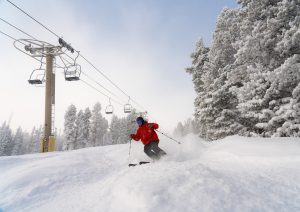Summit County landfill offers a look under the hood as a steep budget cut looms
jqueen@summitdaily.com

Jack Queen / jqueen@summitdaily.com |
If there were an award for prettiest landfill, the Summit County Resource Allocation Park (SCRAP) would be a strong contender. Except it’s a lot more than just a landfill; perched above Highway 9 overlooking the mountains, only a small patch of the 466-acre complex is devoted to burying garbage. Much of the rest is used to keep trash out of the ground, by diverting recyclables, compost and brush to other uses.
Those programs, however, are at risk. In June, trash hauler Timberline Disposal — whose tipping fees make up about 30 percent of SCRAP’s revenue — decided to cut costs by taking garbage waste to landfills outside of the county. Timberline said losing its contract with Vail Resorts, a large chunk of its business, forced the decision.
The loss of that revenue could put recycling and composting programs on the chopping block, and while the county has committed to keeping drop-off centers open through January, it will need to figure out a long-term solution soon.
But negotiations with Timberline have proceeded in fits and starts, and virtually no progress has been made in the past month. All the while, anxiety that Summit County might lose its recycling has grown.
That was the topic on everyone’s mind last week during a tour of SCRAP, which the facility organized in response to the surge in public interest following news of the impending budget gap.
less recycling, more problems
On a rise overlooking the facility, Byrne, the solid waste director for the facility, explained the somewhat counter-intuitive nature of SCRAP’s revenue model: if less trash comes in, the landfill would actually fill up faster; having to cut recycling and composting programs because of the loss in revenue would mean all the material currently being diverted would have to go into the ground.
“If that trash volume changes, we’d have to change a lot of how we operate here,” said Byrne. “Recycling and composting are adding years of life to this facility. Without that, it breaks this model.”
Food scraps alone, for instance, take up a third of the landfill capacity. But now, around 7 percent of that is diverted to two-dozen large brown mounds where it turns into compost — to the delight of local crows.
To the right of that sits an enormous pile of beetle-killed timber, which used to go into the ground. Now, it gets mulched and mixed into the compost piles, saving tens of thousands of tons worth of space.
SCRAP sells its compost at $19 per yard — compared to as much as $35 on the Front Range — and makes a modest profit. But it’s still a low-margin game, as is the recycling operation, which often loses money.
In a warehouse near the main building, workers explained the challenges of the business while a backhoe pushed a mound of flattened boxes onto a conveyor belt.
Recycled commodity prices are at an all time low, and processing plants at home and abroad have become stingier with what types of recyclables they accept. Part of that slowdown has to do with the subsiding euphoria over single-stream recycling, which was originally billed as the ideal way to maximize participation and reduce landfill waste.
Summit County adopted single-stream in 2009, but soon discovered the fly in the ointment: glass. Tiny, pulverized shards of it, damaging machinery and contaminating finished products. That led to a lot of waste, and was plainly counter to the goals of recycling, so the county moved to glass-free single stream in 2014.
“We don’t do ‘feel good’ recycling because we have such a great community that’s willing to separate their stuff,” said Noll. “If you put it in, we’re recycling it. Period.”
For now, at least. While Noll remains confident that the county and local haulers will work out a solution, the fate of this well-oiled machine still hangs in the balance.
WHAT’S AHEAD
County commissioners were scheduled to meet with Timberline earlier this week, but the company cancelled. Now, a sit-down to discuss possible solutions is tentatively slated for next Tuesday.
While the county could invoke a flow-control ordinance and force any haulers operating in the county to bring garbage to SCRAP, Noll said he and his fellow commissioners are hoping to find a less blunt instrument.
“We’re going to look at what we can do, maybe some simple tweaks that will make (the haulers’) lives easier but still meets our goals and still meets their business goals,” he said.
Still, a big chunk of money needs to be found, and it may require some more creative thinking. One of the tour attendees, Maryann Gaug, suggested not negotiating fees with haulers at all, instead going right to the taxpayers.
“There are other models than just haulers paying the tipping fees,” she said. “Maybe we could make a sort of base fee that everyone pays that would include recycling, composting, trash — the whole works — and then the county has a guaranteed income. And if people were paying for it, they might get more interested in recycling and composting.”

Support Local Journalism

Support Local Journalism
As a Summit Daily News reader, you make our work possible.
Summit Daily is embarking on a multiyear project to digitize its archives going back to 1989 and make them available to the public in partnership with the Colorado Historic Newspapers Collection. The full project is expected to cost about $165,000. All donations made in 2023 will go directly toward this project.
Every contribution, no matter the size, will make a difference.









